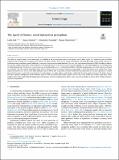The speed of human social interaction perception
Author(s)
Isik, Leyla; Mynick, Anna; Pantazis, Dimitrios; Kanwisher, Nancy
DownloadPublished version (2.060Mb)
Publisher with Creative Commons License
Publisher with Creative Commons License
Creative Commons Attribution
Terms of use
Metadata
Show full item recordAbstract
The ability to perceive others’ social interactions, here defined as the directed contingent actions between two or more people, is a fundamental part of human experience that develops early in infancy and is shared with other primates. However, the neural computations underlying this ability remain largely unknown. Is social interaction recognition a rapid feedforward process or a slower post-perceptual inference? Here we used magnetoencephalography (MEG) decoding to address this question. Subjects in the MEG viewed snapshots of visually matched real-world scenes containing a pair of people who were either engaged in a social interaction or acting independently. The presence versus absence of a social interaction could be read out from subjects’ MEG data spontaneously, even while subjects performed an orthogonal task. This readout generalized across different people and scenes, revealing abstract representations of social interactions in the human brain. These representations, however, did not come online until quite late, at 300 ms after image onset, well after feedforward visual processes. In a second experiment, we found that social interaction readout still occurred at this same late latency even when subjects performed an explicit task detecting social interactions. We further showed that MEG responses distinguished between different types of social interactions (mutual gaze vs joint attention) even later, around 500 ms after image onset. Taken together, these results suggest that the human brain spontaneously extracts information about others’ social interactions, but does so slowly, likely relying on iterative top-down computations.
Date issued
2020-04Department
McGovern Institute for Brain Research at MIT; Center for Brains, Minds, and MachinesJournal
NeuroImage
Publisher
Elsevier BV
Citation
Isik, Leyla et al. "The speed of human social interaction perception." NeuroImage 215 (July 2020): 116844 © 2020 The Authors
Version: Final published version
ISSN
1053-8119